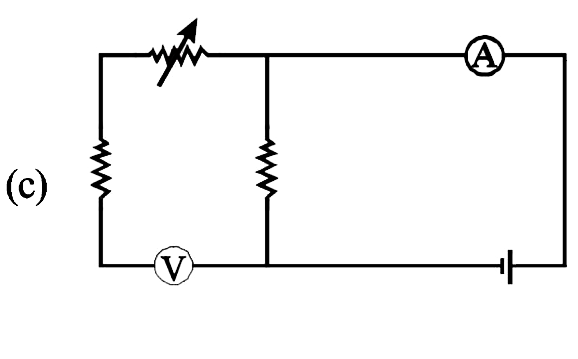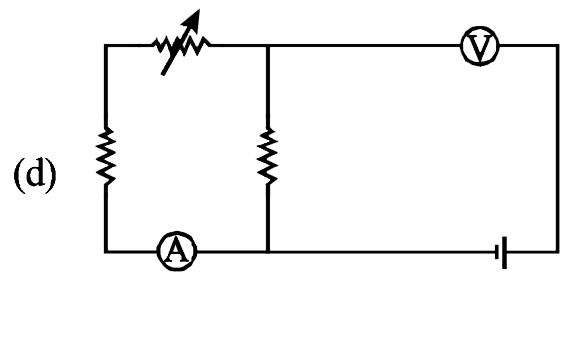Which set-up can be used for verification of Ohm's law?




To verify Ohm's Law, we need to set up an experiment that allows us to measure the voltage across a resistor and the current flowing through it. Ohm's Law states that the current (I) flowing through a conductor between two points is directly proportional to the voltage (V) across the two points, provided the temperature remains constant. The relationship is given by the formula:
V=I×R
where R is the resistance.
1. Gather the Required Equipment:
- A resistor (to provide resistance).
- A power supply (to provide voltage).
- An ammeter (to measure current).
- A voltmeter (to measure voltage).
- Connecting wires.
2. Connect the Circuit:
- Connect the resistor in series with the ammeter. This allows the ammeter to measure the current flowing through the resistor.
- Connect the voltmeter in parallel with the resistor. This allows the voltmeter to measure the voltage across the resistor.
3. Set Up the Power Supply:
- Connect the power supply to the circuit. Ensure that the power supply is adjustable so that you can vary the voltage.
4. Take Measurements:
- Turn on the power supply and set it to a specific voltage.
- Record the current reading from the ammeter and the voltage reading from the voltmeter.
- Repeat this process for different voltage settings to gather multiple sets of data.
5. Analyze the Data:
- Plot a graph of voltage (V) on the y-axis against current (I) on the x-axis.
- If Ohm's Law is verified, the graph should be a straight line passing through the origin, indicating a linear relationship between voltage and current.
6. Calculate Resistance:
- From the slope of the graph, you can determine the resistance (R) using the formula:
R=VI
- A resistor (to provide resistance).
- A power supply (to provide voltage).
- An ammeter (to measure current).
- A voltmeter (to measure voltage).
- Connecting wires.
- Connect the resistor in series with the ammeter. This allows the ammeter to measure the current flowing through the resistor.
- Connect the voltmeter in parallel with the resistor. This allows the voltmeter to measure the voltage across the resistor.
- Connect the power supply to the circuit. Ensure that the power supply is adjustable so that you can vary the voltage.
- Turn on the power supply and set it to a specific voltage.
- Record the current reading from the ammeter and the voltage reading from the voltmeter.
- Repeat this process for different voltage settings to gather multiple sets of data.
- Plot a graph of voltage (V) on the y-axis against current (I) on the x-axis.
- If Ohm's Law is verified, the graph should be a straight line passing through the origin, indicating a linear relationship between voltage and current.
- From the slope of the graph, you can determine the resistance (R) using the formula:
R=VI
Topper's Solved these Questions
- SAMPLE PAPER SELF-ASSESSMENT (11)BOOK - EDUCART PUBLICATIONCHAPTER - SAMPLE PAPER SELF-ASSESSMENT (11)EXERCISE - SECTION -C
1 Videos
- SAMPLE PAPER SELF-ASSESSMENT (11)BOOK - EDUCART PUBLICATIONCHAPTER - SAMPLE PAPER SELF-ASSESSMENT (11)EXERCISE - SECTION -C
1 Videos
- CBSE TERM-1 SAMPLE PAPER 1BOOK - EDUCART PUBLICATIONCHAPTER - CBSE TERM-1 SAMPLE PAPER 1EXERCISE - SECTION-C
6 Videos
Similar Questions
Knowledge Check
Express which of the following set ups can be used to verify
ohm's law?A B
B C
C D
D
Express which of the following set ups can be used to verify Ohm's law.
A B
B C
C D
D
The graph between current I and potential difference V in the experimental verification of Ohm's law were drawn by four students. Which one is correct?
A B
B C
C D
D
Explain the Ohm's law.
View SolutionDraw the circuit for experimental verification of Ohm's law using a source of variable DC voltage, a main resistance of 100Ω, two galvanometers and two resistances of value 106Ω and 10−3Ω respectively. Clearly show the positions of the voltmeter and the ammeter.
View SolutionOhm's law is .
View SolutionIn the experiment of verification of Ohm's law the error in the current measurement is 1%, while that in the voltage measurement is 2%. The error in the resistance has a maximum value of
View SolutionMetallic pipes are used in the experiment for verification of laws of reflection of sound waves. These pipes are highly polished, so that they makes the sound waves to
View Solution
